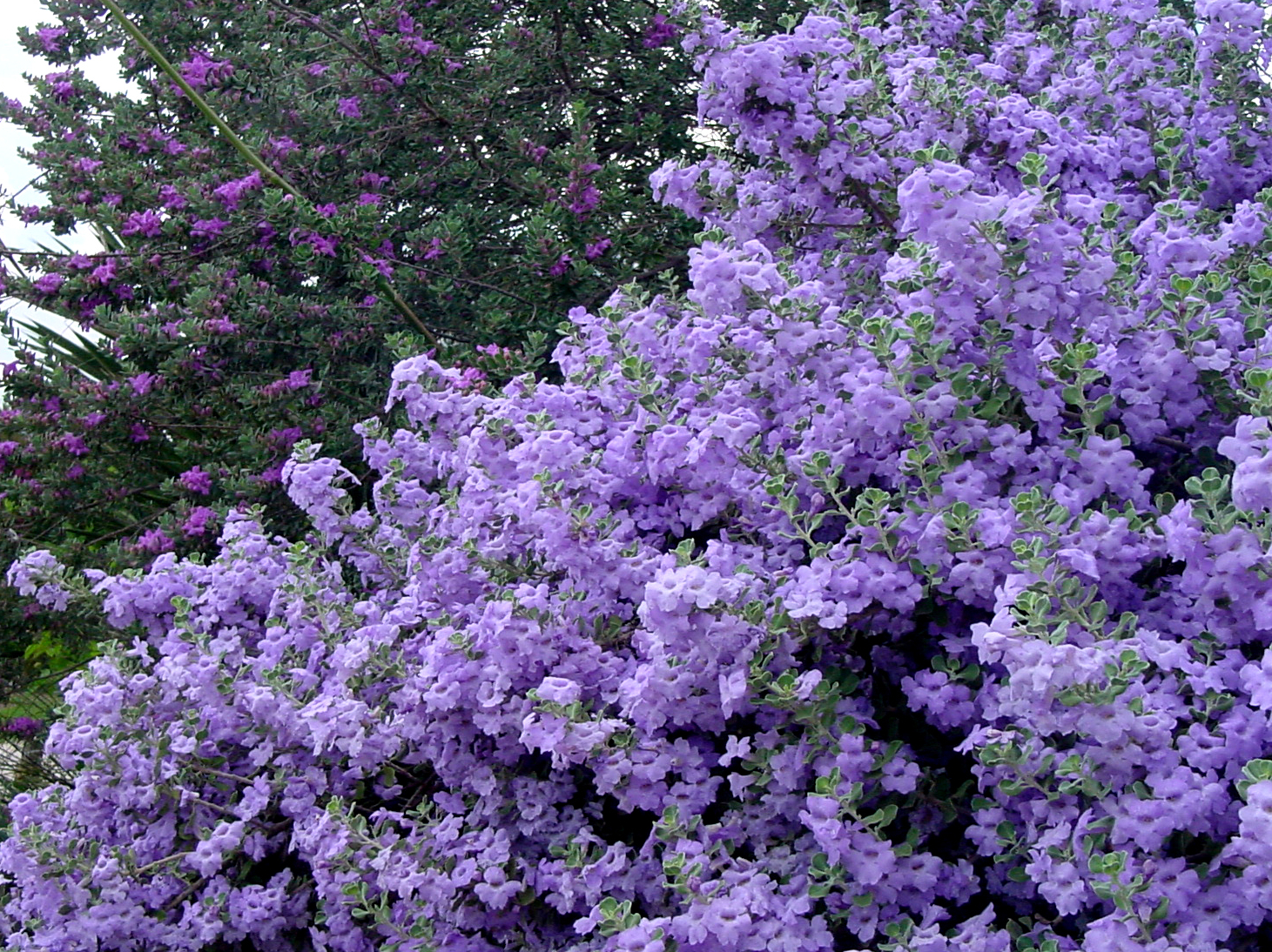College Station, Texas, USA
June 27, 2012
Unlike other sages, Lowrey’s Legacy Cenizo, a new Texas Superstar plant, is not only extremely colorful, but it cycles in and out of bloom much better than other sages, say Texas horticulturists.
“A lot of cenizos will have a flush and bloom in the spring and then kind of sputter — just a little display of flowers until the fall,” said Paul Cox, formerly with San Antonio Botanical Gardens and a lifelong friend of the legendary Texas horticulturist, Lynn Lowrey, after whom the plant is named.
“When Lowrey’s Legacy blooms you literally can’t see the plant because the flowers cover all of it,” said Cox, now retired after 32 years with the gardens.

Lowrey’s Legacy Cenizo’s azalea-like lilac blue flowers are some of the largest and most attractive blooms of any Texas sage on the market, say Texas AgriLife Extension Service and Texas AgriLife Research horticulturists. (Texas AgriLife Extension Service photo)
Texas Superstar plants undergo extensive tests at Overton, Lubbock, San Antonio and College Station by Texas AgriLife Research and Texas AgriLife Extension Service horticulturists, said Dr. Br ent Pemberton, AgriLife Research horticulturist and chair of the Texas Superstar executive board. To be designated a Superstar, a plant must not just be beautiful but also perform well for consumers and growers throughout Texas. Superstars must also be easy to propagate, which should ensure the plants are not only widely available throughout Texas but also are reasonably priced.
Lowrey’s Legacy Cenizo meets all those requirements, Pemberton said. It’s beautiful, easy to care for, with “superb drought tolerance and excellent deer resistance. Its green foliage provides a wonderful backdrop for its large azalea-like lilac blue flowers, delivering some of the largest and most attractive blooms of any Texas sages on the market today. For birders, this plant is a ‘must’ for attracting hummingbirds.”
And naming the species a Texas Superstar also serves to honor one of the most well-known and best-liked horticulturists in Texas, he said.
Cox remembers having many of the original selections in the San Antonio Botanical Gardens that Lowrey rescued from a roadside near Monterrey, Mexico. He also remembers Lowrey as a shy, modest and unassuming man, he said, but essential to the gardens’ goal developing a “comprehensive collection” of native plants.
“I’d come into work one day, and there’d be a truckload of plants on the doorstep that he had decided we couldn’t live without,” Cox said. “He’d drive over on the weekend without speaking or talking to anybody, drop the plants off then leave again. He didn’t charge us or anything. It was always kind of fun to walk up to the door and there’d be a bunch of plants we didn’t order.”

Lowrey’s Legacy Cenizo is sometimes called ‘Lynn’s Ever-blooming’ Texas sage, because of the reliable and continuous profusion of flower displayed throughout much of the year, say Texas AgriLife Extension Service and Texas AgriLife Research horticulturists. (Texas AgriLife Extension Service photo)
Various cenizo sages had been on the market for some time before Lowrey discovered what he recognized as a unique species, Cox said. The species was growing on a rise by a roadside, near a bridge, and the story goes that Lowrey had to stand on the passenger’s seat and reach up to collect samples while traffic was passing.
“He was quick to spot something that had any kind of difference to it,” Cox said. “Unfortunately for Lynn, there were so many things he collected that he really didn’t get the recognition that he deserved. But he didn’t want recognition. He was a shy and retiring person.”
Cox, who is the senior author of “Texas Trees: A Friendly Guide,” now in its ninth printing, remembers one instance in particular that exemplifies his friend’s attitude toward fame.
“They found a new un-described genus of tree in Mexico that they wanted to name after Lynn, and Lynn got mad, got furious and said if you do that he would never talk to you again,” he said. “They named it after somebody else.”
Lowery passed away in 1997. Other great plants he has been credited with introducing to the nursery trade include Mexican sycamore, Montezuma cypress, Monterrey oak and Basham’s Party Pink crape myrtle, all popular plants, Pemberton said. But Lowrey’s Legacy Cenizo has traits to make it just as popular.
“It does well even in droughty areas with a lot of reflected heat, such as median areas along city streets and highways,” Pemberton said. “This plant will not only save time and water, but also will provide a spectacular show of lilac blue flowers periodically throughout the year.”
It is also much more compact than other cenizo sages, Cox noted.
“There are some really compact cenizo’s out there, but in the overall scheme of things it’s much more compact than a lot of the common varieties,” he said. “If you don’t cut them back they just get 8-feet tall and look like hell. The ones (Lowrey’s Legacy Cenizos) that we do at the garden do nicely and have good forms. We always joked we ought to name them either Raquel Welch or Sophia Loren because they bloom gracefully and age gracefully. A lot of cenizo’s don’t do that.”
“It has a natural size of 4 to 5 feet tall and a similar width, which makes for a dense, well-rounded and shapely form,” Pemberton added. “The plant does not develop that ‘leggy’ appearance many Texas cenizo sages develop over-time.”
Texas Superstar is a registered trademark owned by AgriLife Research, a state agency that is part of the Texas A&M University System. More information about the Texas Superstar program can be found at http://texassuperstar.com/.
Lowrey’s detailed biography can be found on the Aggie Horticulture website at http://aggie-horticulture.tamu.edu/archives/parsons/heroes/lowrey2.html.